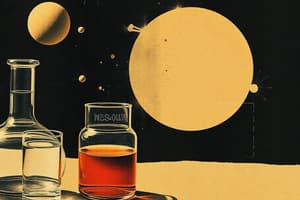Podcast
Questions and Answers
What is a solution in chemistry?
What is a solution in chemistry?
A homogeneous mixture of two or more substances, with one substance (solute) dissolved in the other (solvent).
What is a homogeneous solution?
What is a homogeneous solution?
A solution where the solute is completely dissolved in the solvent, and the mixture appears uniform.
What is a saturated solution?
What is a saturated solution?
A solution where the solvent is unable to dissolve any more solute, resulting in a saturated solution.
What is a suspension in chemistry?
What is a suspension in chemistry?
Why are suspensions generally more unstable than solutions?
Why are suspensions generally more unstable than solutions?
What are the three types of solutions?
What are the three types of solutions?
What is the turbid appearance of a suspension?
What is the turbid appearance of a suspension?
What is the uneven distribution characteristic of a suspension?
What is the uneven distribution characteristic of a suspension?
Why do not all solutes dissolve in a suspension?
Why do not all solutes dissolve in a suspension?
Give an example of a homogeneous solution.
Give an example of a homogeneous solution.
What is an example of a suspension?
What is an example of a suspension?
Explain the difference between solutions and suspensions.
Explain the difference between solutions and suspensions.
Flashcards are hidden until you start studying
Study Notes
Solution and Suspension
In the realm of chemistry, solutions and suspensions are two important types of mixtures. They differ in terms of the dispersed phase and the continuous phase, as well as their stability, appearance, and ease of separation. Let's take a closer look at the types of solutions and the characteristics of suspensions.
Types of Solutions
A solution is a homogeneous mixture of two or more substances, where one of the substances, the solute, is dissolved in the other, the solvent. The solute is typically a solid, liquid, or gas, and when dissolved, it forms a stable dispersion in the solvent. Solutions are classified into three types:
-
Homogeneous solutions: The solute is completely dissolved in the solvent, and the mixture appears uniform.
-
Heterogeneous solutions: The solute does not dissolve completely in the solvent, resulting in a turbid or cloudy appearance.
-
Saturated solutions: The solvent is unable to dissolve any more solute, resulting in a saturated solution.
Characteristics of Suspensions
Suspensions are heterogeneous mixtures made up of solid particles suspended in a liquid or gaseous medium. They are generally more unstable than solutions and can settle out over time due to gravity. Suspensions have the following characteristics:
-
Turbid appearance: Suspensions appear cloudy or opaque due to the presence of suspended particles.
-
Uneven distribution: The solid particles in a suspension are not evenly distributed throughout the mixture, leading to a heterogeneous appearance.
-
Not all solutes dissolve: In a suspension, not all solute particles are dissolved in the solvent, leading to the formation of a precipitate.
Examples of Solutions and Suspensions
Let's consider some examples to better understand the differences between solutions and suspensions:
-
Saltwater: This is an example of a homogeneous solution, where salt (solute) is dissolved in water (solvent).
-
Milk: Milk is an example of a suspension, where the fat globules are suspended in water.
-
Tea: Tea is another example of a suspension, where tea particles are suspended in hot water.
In conclusion, solutions and suspensions are two distinct types of mixtures in the world of chemistry. Solutions are homogeneous mixtures where a solute is completely dissolved in a solvent, while suspensions are heterogeneous mixtures where solid particles are suspended in a liquid or gaseous medium. Understanding the differences between these two types of mixtures is crucial for various applications in everyday life and in scientific research.
Studying That Suits You
Use AI to generate personalized quizzes and flashcards to suit your learning preferences.




